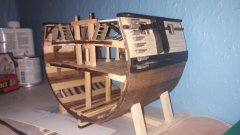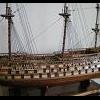-
Posts
3,084 -
Joined
-
Last visited
Reputation Activity
-
 Jaager got a reaction from popeye the sailor in Meteor 1851 by Jim Lad - Scale 1:96 - Immigrant Ship
Jaager got a reaction from popeye the sailor in Meteor 1851 by Jim Lad - Scale 1:96 - Immigrant Ship
When the time comes that you do the masts and rigging,
the NRJ reprinted the following, I think Dutch, 19th century book in at least 19 parts
LE COMTE: PRAKTIKALE ZEEVAARTKUNDE PT. 1
EDSON,MERRITT
NAUTICAL RESEARCH JOURNAL
1974
20
170-182
MASTING RIGGING 19TH DUTCH
The CD for volumes 1-40 should cover it.
It may be more germane than English or US texts.
There is also a reprint that may be still available covering ship building close to your subject in its region.
VORLEGE-BLATTER FUR SCHIFF-BAUER 1835
KLAWITTER,GUSTAV D
HORST HAMECHER
KASSEL
1978
SHIP BUILDING
I grabbed what I could of reprints, when available figuring that the window was a narrow one - this being well before PDF.
-
 Jaager got a reaction from davyboy in Boxwood and how to get it
Jaager got a reaction from davyboy in Boxwood and how to get it
As long as we are exercising a fantasy, Faster growth means wider rings, does this not affect density?
A GMO may be unnecessary and more likely to yield form over substance as a product, which is what advertising and
wishful thinking gets us now. . I think it makes for a higher probability of success for someone far in the future if
lots of lands was set aside for the arbor culture of Buxus simpervirens cultivars that grow straight and tall, and are not
palatable to aphids, chomping insects, fungii, in an eco environment with mixed species to discourage the establishment of
Buxus dedicated persistent parasite populations. The time necessary until harvest makes close attention to growing conditions uneconomical.
More likely would be Bush Hogging the weeds every 5-10 years as all the attention. it gets. Otherwise, it is plant and forget.
However, looming just off stage :
a probable environment higher in CO2 and warmer in many regions. Plants that like that will grow faster and for a longer part of the annual period.
This may reduce the density. Unfortunately, milder winters mean that pest species will be culled less and others will migrate from warmer climes.
If all that goes well, just wait a couple hundred years and we are set - presupposing the coming system changes leave a population able to utilize the wood..
-
 Jaager got a reaction from thibaultron in New monograph : L'Egyptienne French 24prd frigate 1799
Jaager got a reaction from thibaultron in New monograph : L'Egyptienne French 24prd frigate 1799
My copy is just here. From paging the book, Wow! If any details were missed, They have to be microscopic.
A truly magnificent tour de force.
Gerard, What's next, Old Son?
-
 Jaager got a reaction from BETAQDAVE in Boxwood and how to get it
Jaager got a reaction from BETAQDAVE in Boxwood and how to get it
Bob,
I have not read that one before, but it seems to reflect the reality of the situation, if not the actual cause. Buxus sempervirens seems to have been loved to death.
The imp on my shoulder prods me to make a glib answer = for enough Buxus to provide frame timbers for a large scale multi deck vessel, a Wayback machine is probably needed.
I recall reading that Harold Hahn had acquired a supply. But he was mostly 1:96. The strength is helpful in the miniature or semi-miniature scales, fur suure.
-
 Jaager got a reaction from mtaylor in Apple turning blank - drying
Jaager got a reaction from mtaylor in Apple turning blank - drying
Bill,
Dogwood trunks are sort of small, so getting sizable billets is difficult. It is among the hardest domestic wood.
The color is good, grain excellent. It would work for everything, if it could be had in large enough pieces.
It is in the elite group for carving, knees, breast hooks, posts, cat heads, other fragile parts. I have some from a
relative in Caroline Co. . If I had easy access, I would gather as much as I could. It is probably not well known, because
it is so difficult to obtain.
Two others you may run across, that are worth the effort = Honey Locust and ornamental Pear (street plantings) (Bradford here).
But for me, Apple is king.
-
 Jaager got a reaction from mtaylor in Black or natural thread?
Jaager got a reaction from mtaylor in Black or natural thread?
I run with the following scenario :
prior to 1860 and commercial petroleum, tar was obtained from conifers, with the Baltic region being the major supplier.
It is closer to dark walnut dye than 0,0,0 black. A serious coat on standing rigging and a light coat on running rigging.
Hemp and later Manila hemp fibers are not white to begin with.
-
 Jaager got a reaction from Mark P in Boxwood and how to get it
Jaager got a reaction from Mark P in Boxwood and how to get it
Bob,
I have not read that one before, but it seems to reflect the reality of the situation, if not the actual cause. Buxus sempervirens seems to have been loved to death.
The imp on my shoulder prods me to make a glib answer = for enough Buxus to provide frame timbers for a large scale multi deck vessel, a Wayback machine is probably needed.
I recall reading that Harold Hahn had acquired a supply. But he was mostly 1:96. The strength is helpful in the miniature or semi-miniature scales, fur suure.
-
 Jaager got a reaction from davyboy in Black or natural thread?
Jaager got a reaction from davyboy in Black or natural thread?
I run with the following scenario :
prior to 1860 and commercial petroleum, tar was obtained from conifers, with the Baltic region being the major supplier.
It is closer to dark walnut dye than 0,0,0 black. A serious coat on standing rigging and a light coat on running rigging.
Hemp and later Manila hemp fibers are not white to begin with.
-
 Jaager got a reaction from allanyed in Black or natural thread?
Jaager got a reaction from allanyed in Black or natural thread?
I run with the following scenario :
prior to 1860 and commercial petroleum, tar was obtained from conifers, with the Baltic region being the major supplier.
It is closer to dark walnut dye than 0,0,0 black. A serious coat on standing rigging and a light coat on running rigging.
Hemp and later Manila hemp fibers are not white to begin with.
-
 Jaager got a reaction from Bob Cleek in Black or natural thread?
Jaager got a reaction from Bob Cleek in Black or natural thread?
I run with the following scenario :
prior to 1860 and commercial petroleum, tar was obtained from conifers, with the Baltic region being the major supplier.
It is closer to dark walnut dye than 0,0,0 black. A serious coat on standing rigging and a light coat on running rigging.
Hemp and later Manila hemp fibers are not white to begin with.
-
 Jaager got a reaction from Piet in Meteor 1851 by Jim Lad - Scale 1:96 - Immigrant Ship
Jaager got a reaction from Piet in Meteor 1851 by Jim Lad - Scale 1:96 - Immigrant Ship
When the time comes that you do the masts and rigging,
the NRJ reprinted the following, I think Dutch, 19th century book in at least 19 parts
LE COMTE: PRAKTIKALE ZEEVAARTKUNDE PT. 1
EDSON,MERRITT
NAUTICAL RESEARCH JOURNAL
1974
20
170-182
MASTING RIGGING 19TH DUTCH
The CD for volumes 1-40 should cover it.
It may be more germane than English or US texts.
There is also a reprint that may be still available covering ship building close to your subject in its region.
VORLEGE-BLATTER FUR SCHIFF-BAUER 1835
KLAWITTER,GUSTAV D
HORST HAMECHER
KASSEL
1978
SHIP BUILDING
I grabbed what I could of reprints, when available figuring that the window was a narrow one - this being well before PDF.
-
 Jaager got a reaction from EricWilliamMarshall in Is there a Beginner’s Guide to Metal Work?
Jaager got a reaction from EricWilliamMarshall in Is there a Beginner’s Guide to Metal Work?
Unless I am mis remembering
PLANK ON FRAME MODELS VOL.1 & 2 1958
UNDERHILL,HAROLD A
BROWN, SON & FERGISON
He shows how to form up for soldering and removing the alignment surplus
AMERICAN FISHING SCHOONERS 1825-1935, THE
CHAPELLE,H I
W W NORTON CO NEW YORK 1973
Has drawings of the actual hardware in the appendix
only guesses for a general how to. The following are from my Amazon wish list from recommendations here
Model Building with Brass Hardcover – March 27, 2012
by Kenneth C. Foran
Jewelry: Fundamentals of Metalsmithing (Jewelry Crafts) Hardcover – September 15, 1997
by Tim Mccreight
The Complete Metalsmith: An Illustrated Handbook Spiral-bound – December 31, 1991
by Tim McCreight
-
 Jaager got a reaction from Canute in Is there a Beginner’s Guide to Metal Work?
Jaager got a reaction from Canute in Is there a Beginner’s Guide to Metal Work?
Unless I am mis remembering
PLANK ON FRAME MODELS VOL.1 & 2 1958
UNDERHILL,HAROLD A
BROWN, SON & FERGISON
He shows how to form up for soldering and removing the alignment surplus
AMERICAN FISHING SCHOONERS 1825-1935, THE
CHAPELLE,H I
W W NORTON CO NEW YORK 1973
Has drawings of the actual hardware in the appendix
only guesses for a general how to. The following are from my Amazon wish list from recommendations here
Model Building with Brass Hardcover – March 27, 2012
by Kenneth C. Foran
Jewelry: Fundamentals of Metalsmithing (Jewelry Crafts) Hardcover – September 15, 1997
by Tim Mccreight
The Complete Metalsmith: An Illustrated Handbook Spiral-bound – December 31, 1991
by Tim McCreight
-
 Jaager got a reaction from mtaylor in Is there a Beginner’s Guide to Metal Work?
Jaager got a reaction from mtaylor in Is there a Beginner’s Guide to Metal Work?
Unless I am mis remembering
PLANK ON FRAME MODELS VOL.1 & 2 1958
UNDERHILL,HAROLD A
BROWN, SON & FERGISON
He shows how to form up for soldering and removing the alignment surplus
AMERICAN FISHING SCHOONERS 1825-1935, THE
CHAPELLE,H I
W W NORTON CO NEW YORK 1973
Has drawings of the actual hardware in the appendix
only guesses for a general how to. The following are from my Amazon wish list from recommendations here
Model Building with Brass Hardcover – March 27, 2012
by Kenneth C. Foran
Jewelry: Fundamentals of Metalsmithing (Jewelry Crafts) Hardcover – September 15, 1997
by Tim Mccreight
The Complete Metalsmith: An Illustrated Handbook Spiral-bound – December 31, 1991
by Tim McCreight
-
 Jaager got a reaction from Bob Cleek in Is there a Beginner’s Guide to Metal Work?
Jaager got a reaction from Bob Cleek in Is there a Beginner’s Guide to Metal Work?
Unless I am mis remembering
PLANK ON FRAME MODELS VOL.1 & 2 1958
UNDERHILL,HAROLD A
BROWN, SON & FERGISON
He shows how to form up for soldering and removing the alignment surplus
AMERICAN FISHING SCHOONERS 1825-1935, THE
CHAPELLE,H I
W W NORTON CO NEW YORK 1973
Has drawings of the actual hardware in the appendix
only guesses for a general how to. The following are from my Amazon wish list from recommendations here
Model Building with Brass Hardcover – March 27, 2012
by Kenneth C. Foran
Jewelry: Fundamentals of Metalsmithing (Jewelry Crafts) Hardcover – September 15, 1997
by Tim Mccreight
The Complete Metalsmith: An Illustrated Handbook Spiral-bound – December 31, 1991
by Tim McCreight
-
 Jaager got a reaction from Ryland Craze in Is there a Beginner’s Guide to Metal Work?
Jaager got a reaction from Ryland Craze in Is there a Beginner’s Guide to Metal Work?
Unless I am mis remembering
PLANK ON FRAME MODELS VOL.1 & 2 1958
UNDERHILL,HAROLD A
BROWN, SON & FERGISON
He shows how to form up for soldering and removing the alignment surplus
AMERICAN FISHING SCHOONERS 1825-1935, THE
CHAPELLE,H I
W W NORTON CO NEW YORK 1973
Has drawings of the actual hardware in the appendix
only guesses for a general how to. The following are from my Amazon wish list from recommendations here
Model Building with Brass Hardcover – March 27, 2012
by Kenneth C. Foran
Jewelry: Fundamentals of Metalsmithing (Jewelry Crafts) Hardcover – September 15, 1997
by Tim Mccreight
The Complete Metalsmith: An Illustrated Handbook Spiral-bound – December 31, 1991
by Tim McCreight
-
 Jaager got a reaction from mtaylor in Apple turning blank - drying
Jaager got a reaction from mtaylor in Apple turning blank - drying
Robert,
It is my experience that a bandsaw is more useful and safer than a table saw. Your 4" table saw should suffice for anything specific to that type of tool.
A 10" table saw is ready to eat your fingers given the least chance. My 10" Ryobi table saw has a larger foot print than my 14" Rikon band saw, so no
advantage there. You do want 220V for a band saw and $60 bimetal or $200 Resawking for the blade necessary for resawing - ouch!
Rather than weighing, Amazon has inexpensive moisture meters. Unless you open a saw mill, close enough should do for accuracy.
-
 Jaager got a reaction from mtaylor in Apple turning blank - drying
Jaager got a reaction from mtaylor in Apple turning blank - drying
Robert,
Your wax covered - hope that the moisture level when hermetically sealed was below what a fungus requires. Unlike Holly, the fungus that eats Apple really turns it into poop.
I am guessing that pen blanks are about as costly per board foot for a source of wood as can be had. Turning blanks could be just behind.
2" of a relatively hard wood like Apple would be a chore for a 10" table saw. A Byrnes saw can come close to 1" - depending on the blade.
Cutting thick stock would likely require several passes even before you flip it. The blade - low number of teeth and carbide tips with enough
offset to produce a cost inefficient kerf.
( Your location is a fairly populous one, no? You should be able to find someone with a 14" or larger bandsaw - with a resaw blade [carbide or bimetal] - the kerf will be as narrow as can be had and the speed with a 12" long billet will make you cry after the experience with a small table saw.)
Apple - for me - is right at the top of desirable species for POF. Be mindful that there are many varieties, so there will be variations. I think the grandfather root stock and heirloom varieties are good ones.
It is not as difficult to source as the unicorn Buxus sempervirens, but it is difficult. Apple trees transport a lot of sugars and while drying, a fungus can rot the wood, if you unlucky and the stock being dried is too thick. I apologize for not remembering the attribution, but one of us provided a link to a significant source for Apple - Hearne Hardwoods https://www.hearnehardwoods.com/apple-american-lumber/ I thank him for this. Found him - Gregory - thanks again.
Now about rapid drying - a commercial kiln - controlled by someone who knows the necessary time and temp is best. If you like to gamble - you can build an inexpensive drying box.
Six sides - length width depth your choice - material pink or blue Styrofoam house sheathing insulation (I used 1" with foil on one surface.) - comes 4 x 8 but Home Depot sells smaller craft size pieces - push fit - air leaks wanted.
Heat source - 200W -300W incandescent light bulbs - Al foil and air gape between the bulb and the easily charred foam. A thermometer and a dimmer switch gives some control. I kept the temp under 120 degrees F.
Ventilation - in a hole a one end - a surplus muffin computer cooling fan - most are low cost - the trick is the power source.
I used it to dry Holly and beat the Blue Mold to the wood without significant twisting or checking.
-
 Jaager got a reaction from mtaylor in gun ports
Jaager got a reaction from mtaylor in gun ports
For gun ports, not only is the height of the sills determined by the position of the deck, the slope of the sills is determined by the slope of the deck.
Endeavor was a collier? The USS Maine demonstrated the danger of poorly vented coal, Would that cargo not want venting?
Flat plans + curved surface - do not match. I would pick a landmark as close to the port as possible and gauge from that - going from each side and interpolating any difference.
The port dimensions are all the same, but on the profile plan the bow port would appear smaller on the X dimension.
-
 Jaager got a reaction from Canute in Glue to use for gluing cut sheets to wood.
Jaager got a reaction from Canute in Glue to use for gluing cut sheets to wood.
What works for me is a good quality rubber cement - Best Test is what I prefer. The trick is to use a very liberal and full coverage coat on both surfaces.
Let it dry a bit and then stick. this method does not favor further adjustment, so a careful aim is needed. The solvent is volatile and the cement can get
too thick, so I have a quart of the solvent Bestine (n-hepane) and use a pipette to add small volumes to keep the cement at the correct viscosity.
I work from a 120ml applicator cap bottle, but buy it in quarts.
I cut out the frame timbers for USS Vincennes in 2015 and the patterns are still stuck fast to the pieces - waiting for assembly into frames.
-
 Jaager got a reaction from thibaultron in Glue to use for gluing cut sheets to wood.
Jaager got a reaction from thibaultron in Glue to use for gluing cut sheets to wood.
What works for me is a good quality rubber cement - Best Test is what I prefer. The trick is to use a very liberal and full coverage coat on both surfaces.
Let it dry a bit and then stick. this method does not favor further adjustment, so a careful aim is needed. The solvent is volatile and the cement can get
too thick, so I have a quart of the solvent Bestine (n-hepane) and use a pipette to add small volumes to keep the cement at the correct viscosity.
I work from a 120ml applicator cap bottle, but buy it in quarts.
I cut out the frame timbers for USS Vincennes in 2015 and the patterns are still stuck fast to the pieces - waiting for assembly into frames.
-
 Jaager got a reaction from Canute in Proxxon jigsaw or a scroll saw
Jaager got a reaction from Canute in Proxxon jigsaw or a scroll saw
If you are really doing POF, since you wrote "cutting frames", depending on your scale and the size of the vessel,
The timbers for a first rate liner @ 1:48 can easily exceed 1/4" in thickness. Madness as a choice to be sure, since
when the hull is assembled, you have to decide who gets the house, you or it. I wonder if this tool is up to the job.
I suspect that control is better with a fixed blade and a moving piece of stock. My crystal ball foresees heart ache and
frustration, given the hundreds of frames timbers needed for one hull. If you miss typed and it is plywood molds for
POB that needs cutting, this may help reduce the work. A fixed blade would still be easier. The motor and blade mount
will limit your ability to see the cut.
The time that a high end scroll saw saves in dressing with a disk or drum sander may not be enough to justify the expenditure.
I get the job done with a generic 9" band saw - a 1/4" blade - and a Carter Stabilizer. The always down cutting force of a band saw
eliminates the stock jumping up problem, the Carter add on allows very tight curves. It helps to choose a saw with a blade length
that is commonly available.
-
 Jaager got a reaction from Edwardkenway in Proxxon jigsaw or a scroll saw
Jaager got a reaction from Edwardkenway in Proxxon jigsaw or a scroll saw
If you are really doing POF, since you wrote "cutting frames", depending on your scale and the size of the vessel,
The timbers for a first rate liner @ 1:48 can easily exceed 1/4" in thickness. Madness as a choice to be sure, since
when the hull is assembled, you have to decide who gets the house, you or it. I wonder if this tool is up to the job.
I suspect that control is better with a fixed blade and a moving piece of stock. My crystal ball foresees heart ache and
frustration, given the hundreds of frames timbers needed for one hull. If you miss typed and it is plywood molds for
POB that needs cutting, this may help reduce the work. A fixed blade would still be easier. The motor and blade mount
will limit your ability to see the cut.
The time that a high end scroll saw saves in dressing with a disk or drum sander may not be enough to justify the expenditure.
I get the job done with a generic 9" band saw - a 1/4" blade - and a Carter Stabilizer. The always down cutting force of a band saw
eliminates the stock jumping up problem, the Carter add on allows very tight curves. It helps to choose a saw with a blade length
that is commonly available.
-
 Jaager got a reaction from pontiachedmark in Proxxon jigsaw or a scroll saw
Jaager got a reaction from pontiachedmark in Proxxon jigsaw or a scroll saw
If you are really doing POF, since you wrote "cutting frames", depending on your scale and the size of the vessel,
The timbers for a first rate liner @ 1:48 can easily exceed 1/4" in thickness. Madness as a choice to be sure, since
when the hull is assembled, you have to decide who gets the house, you or it. I wonder if this tool is up to the job.
I suspect that control is better with a fixed blade and a moving piece of stock. My crystal ball foresees heart ache and
frustration, given the hundreds of frames timbers needed for one hull. If you miss typed and it is plywood molds for
POB that needs cutting, this may help reduce the work. A fixed blade would still be easier. The motor and blade mount
will limit your ability to see the cut.
The time that a high end scroll saw saves in dressing with a disk or drum sander may not be enough to justify the expenditure.
I get the job done with a generic 9" band saw - a 1/4" blade - and a Carter Stabilizer. The always down cutting force of a band saw
eliminates the stock jumping up problem, the Carter add on allows very tight curves. It helps to choose a saw with a blade length
that is commonly available.
-
 Jaager got a reaction from BLACK VIKING in Proxxon jigsaw or a scroll saw
Jaager got a reaction from BLACK VIKING in Proxxon jigsaw or a scroll saw
If you are really doing POF, since you wrote "cutting frames", depending on your scale and the size of the vessel,
The timbers for a first rate liner @ 1:48 can easily exceed 1/4" in thickness. Madness as a choice to be sure, since
when the hull is assembled, you have to decide who gets the house, you or it. I wonder if this tool is up to the job.
I suspect that control is better with a fixed blade and a moving piece of stock. My crystal ball foresees heart ache and
frustration, given the hundreds of frames timbers needed for one hull. If you miss typed and it is plywood molds for
POB that needs cutting, this may help reduce the work. A fixed blade would still be easier. The motor and blade mount
will limit your ability to see the cut.
The time that a high end scroll saw saves in dressing with a disk or drum sander may not be enough to justify the expenditure.
I get the job done with a generic 9" band saw - a 1/4" blade - and a Carter Stabilizer. The always down cutting force of a band saw
eliminates the stock jumping up problem, the Carter add on allows very tight curves. It helps to choose a saw with a blade length
that is commonly available.



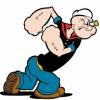



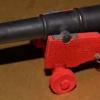

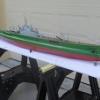
.thumb.jpeg.fc5d633a7b34428fcf19419a73d56d55.jpeg)


